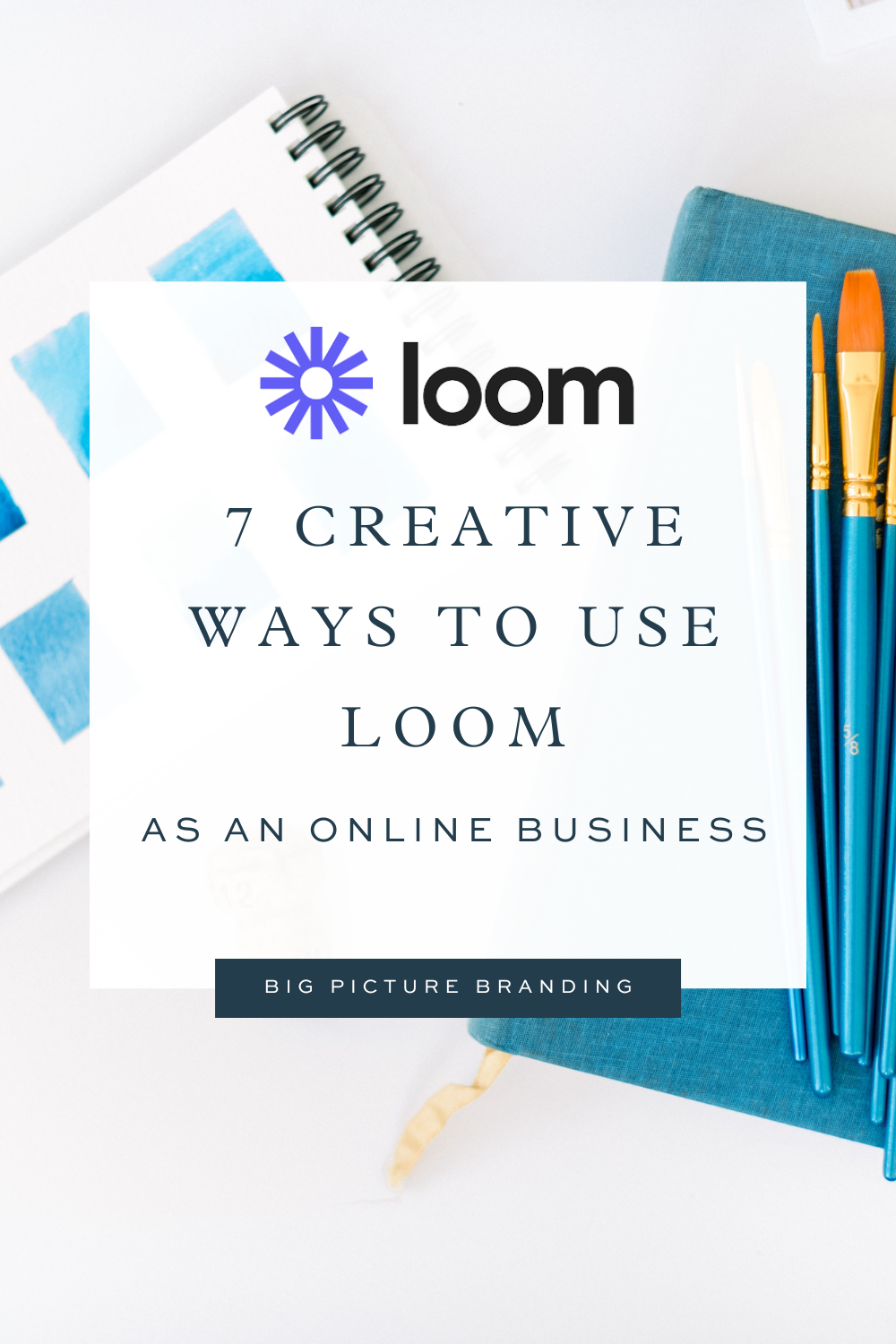As an online business owner categorically allergic to meetings but a stickler for good (and frequent) communication, Loom recording and messaging is the most important tool I use in my brand strategy and copywriting business.
Loom sits alongside Google docs as the business tool that touches all facets of my business from client communications to team/contractor management to educational course materials. I use it to walk clients through work in progress and present final deliverables on-screen. I send contractors onboarding/offboarding information and even recorded every module of my copy coaching cohort course using Loom.
If you’re unfamiliar, Loom allows you to record yourself or your screen and store your videos in your Loom library — meaning you don’t have to use up valuable gigabytes or cloud storage to host or keep your ginormous video files.
My favorite Loom features include:
-
Automatic prompts for recipients to record a response.
-
Customizable CTAs you can embed directly within the video.
-
Ability to leave emoji feedback. (My clients frequently use ❤️, 😍, and 👍.)
-
One-click link sharing.
-
Face time bubble feature. (You have the option to record both your screen and face. A small bubble appears toward the bottom corner of the screen so you can still connect face-to-face while presenting, which helps with engagement.)
-
Content security. (You can restrict viewing by email address and add password protection.)
-
Closed captions/transcription makes Loom a more accessible product and makes searching keywords and phrases within a video easier.
In addition to helping me keep my money in my pocket instead of giving it to iCloud storage every month, here are a few of the biggest benefits of using Loom for business:
Time zone and lifestyle-friendly
Asynchronous communication (communication that doesn’t happen in real-time) means my clients and contractors can watch my videos whenever works best for their schedules. This is especially valuable for those working in various time zones across and outside the U.S. I’ve had clients and students watch my videos from the U.K., South Africa, Australia, Tasmania, and even Bhutan.
Beyond timezones, I work with a lot of side-hustlers — business owners building businesses in addition to another full-time job and/or while being a parent or caregiver. (A.K.A. Modern-day heroes.)
Loom video communications take the pressure off needing to respond immediately and instead allow you to watch and work whenever works best for you. When the immediacy is turned down a notch, I’ve noticed that more thoughtful and thorough feedback follows.
Fewer meetings and time savings
Once you start using Loom you find yourself thinking, “This meeting could have been a Loom.” Let me walk you through a before and after use case in my business:
Deliverables Handoff Before Loom:
-
Schedule client handoff meeting (5 minutes)
-
Reschedule client handoff to accommodate a last-minute conflict (5 minutes)
-
Host meeting (1 hour)
-
Email follow-up notes and questions (20 minutes)
-
Feedback reminder email (5 minutes)
-
Schedule a follow-up meeting requested by the client (5 minutes)
-
Host follow-up meeting to clarify notes (30 minutes)
-
Email follow-up notes (20 minutes)
-
Email updated deliverables for handoff (15 minutes)
-
Schedule final check-in meeting (5 minutes)
-
Host final check-in meeting (30 minutes)
TOTAL WORKFLOW TIME WITHOUT LOOM: 3 hours and 20 minutes
Deliverables Handoff After Loom:
-
Record Loom walking through deliverables including follow-up and feedback notes in the video comments section. (20 minutes)
-
Send deliverables email including video link and copy/pasted notes and feedback request. (5 minutes)
-
Receive Loom notification that the client has watched your Loom and responded to the automatic prompt to record a video reply with feedback notes. (5 minutes)
-
Send final updated deliverables. No follow-ups are needed. (5 minutes)
TOTAL WORKFLOW TIME WITHOUT LOOM: 35 minutes
I rest my case.
Clearer communication
Sometimes you need to see it to believe it and this is especially true when it comes to copywriting. With Loom, I’m able to pull up my copy docs as well as any wireframes or visuals I typically use to show clients how their copy might look once it’s integrated with design and installed on their new site.
When clients are able to see what I’m talking about, visually, confusion and misinterpretations become a thing of the past (which means fewer follow-up meetings and back-and-forth emails!)
Feedback loops are vital to the copywriting process. The automatic prompt to record a Loom response keeps the momentum moving forward and the face-to-face aspect helps people process information more deeply than if they were simply staring at an email communication.
High-touch client experience
Even though I am often thousands of miles away from my client’s workplace, video offers a close second to face-to-face interactions. Clients new to Loom are impressed with how easy and efficient it is to use. Many have even integrated Loom into their own workflows because, aside from its productivity capabilities, it allows you to show up professionally, and personally. As remote work continues to grow, staying connected to each other has become essential, and nowhere is that more important than for service-based online businesses.
7 Ways I Use Loom Video Recording As An Online Business Owner
1) New client welcome video
Put yourself in a new client’s shoes for a sec and just imagine: You’ve plonked down a sizeable cash deposit, signed all the dotted lines, and then…nothing. Having been on both sides of the coin, this.is.the.worst!
Level up your client experience by sending a pre-recorded new client welcome video. If you’ve got an onboarding funnel set up you can throw this into your CRM workflow. (I use Dubsado. Get 20% OFF your first month or YEAR with code bigpicture20.) Be sure to communicate how excited you are to get started, and what to expect next, and remind them if they need to send you any assets or information before your official start date.
Pro tip: With Loom’s video stitching feature, you can stitch together greetings from your whole team!
2) Over-the-shoulder tutorials
Instead of laboriously writing out 50-step instructions, fire up Loom and walk your viewer through the process. This way, viewers can pause, rewind, and rewatch sections as needed. I pepper over-the-shoulder videos throughout blog posts, digital products, and client deliverables.
Here’s an example video I made for the blog post How To Use Testimonials & Survey Results To Write Your Website Copy (+4 minute video tutorial).
3) Customized feedback and FAQs
Have you ever sat down to write a quick email and 45 minutes later you’re finally hitting send? Cut that ish out and record a Loom response instead. I reply to my student and course FAQs with a personalized Loom (and file any FAQs into a dedicated Loom library to use again as needed!) Having the ability to show my students exactly which sections, or words, or point them to an example allows me to communicate more efficiently and effectively.
When it comes to my clients, I’m able to send password-protected feedback videos, keeping all proprietary information safe and secure. Whether I’m working with an online business or startup, no one wants to reveal the bits that end up on the cutting room floor until Launch Day.
4) Internal documentation and onboarding
If you’re training a new employee or passing along a lot of new information, use Loom to walk your team through materials and provide some high-level context for what they’re looking at. Even something as simple as explaining how you organize shared files and folders and why becomes more memorable after watching a two-minute video rather than slogging through a 20-point checklist. While you’ll still need to remind people of your processes and provide constructive feedback (we all learn at different speeds so set aside ample time for training!) your team will be able to return to explainers on-demand, which means less confusion and less having to remind people how to do a certain task.
5) Troubleshooting and customer service
Customer service is a breeze when you can send and receive videos showing the problem in action. I’ve used this to walk clients through email marketing software after delivering their email sequence copy and I’ve also sent my own videos to customer service reps to show them where a funky bug is happening in my account. Even when a mistake is your fault, showing up as a human being can tamp down any feelings of ill-will and lessen the chance of losing a sale or subscriber. When recording customer service responses, remember that humility can go a long way.
6) Evergreen webinar recordings
Forget expensive and complicated video production equipment. All you need to start recording an evergreen webinar is good lighting and Loom. Once recorded, you can edit and stitch together other videos, add strategic CTAs to time markers, and download your finished product or grab the embed code for placement on your landing page or webpage.
7) Course video tutorials
Everything you can do for an evergreen webinar recording can be applied to your course materials, but access to engagement insights is where Loom shines. I use Loom insights to monitor where students are dropping off, replaying, and even who did or did not watch the video at all. Based on this feedback I’m able to check in on student progress and make tweaks to overly-long videos or re-record sections where I needed to be more clear or engaging.
Start replacing tedious meetings with Loom.
Start using Loom for free! When you’re ready to record videos over five minutes in length, you can easily upgrade to one of their paid plans.
Affiliate Disclaimer: When I link to products and services, those links may be affiliate links. If you click on any of those links and make a purchase within a certain time frame I may earn a small commission. The commission is paid by the retailers, at no cost to you. I categorically refuse to promote products and services that don’t align with my values and will only recommend items I use within my own business. #goodkarma
PIN IT TO SAVE FOR LATER

